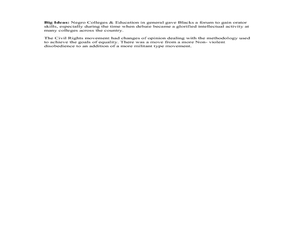Defining US
Integration of Education and American Society
How did the struggle for Civil Rights during the 1950s transform American society and politics? Why are American schools integrated today? Class members explore these essential questions by examining a series of primary and secondary...
Curated OER
Desegregation of Schools
Students explore ways African American students were discriminated against in the 1960's. In this United States History lesson, students read three famous poems on the Civil Rights Movement then write their own poem.
DocsTeach
"We Are Badly in Need of a Breath of Fresh Air": A Letter to President Kennedy About LGBTQ+ Rights
The 1960s were a pivotal time for many Americans who had long been discriminated against. Scholars read a document addressed to President Kennedy in support of LGBTQ+ rights and why they are essential. The activity includes group...
Curated OER
Rosa Parks and the Montgomery Bus Boycott
Students dramatize incident that started the civil rights movement of the 1950s and 1960s: Rosa Parks's refusal to give up her seat on a bus in Montgomery, Alabama.
Curated OER
In the 1960s, Why Were Boston’s Schools Racially Segregated?
Students explore the implications of segregation. For this Civil Rights lesson, students investigate what equal education is as they discover the state of Boston schools in 1960. Students define civil rights and discrimination as they...
Albert Shanker Institute
Who Was Bayard Rustin?
Who was Bayard Rustin? Pupils analyze a series of primary source documents to learn about this important figure in the civil rights movement. The instructional activity contains a short film to watch along with guiding questions and...
Teaching Tolerance
Using Photographs to Teach Social Justice | Confronting Unjust Practices
A powerful photograph of the Freedom Riders of 1961 launches an examination of the de jure and de facto injustices that the civil rights movement of the 1950s and 1960s addressed. Young historians first watch a video and read the Supreme...
Curated OER
History in Literature - The House of Dies Drear
Hook your learners with a great project. They research the underground railroad and civil rights movement through literature, view the video The Underground Railroad: Escape from Slavery, and read the book House of Dies Drear in...
Digital Public Library of America
The Watsons Go To Birmingham—1963 by Christopher Paul Curtis
A primary source set of photographs, videos, newspaper articles, and FBI reports provides insight into race relations during the 1960s, the Sixteenth Street Baptist Church bombing, and the murder of Emmitt Till. Designed to be used to...
Curated OER
The Kennedy Administration and the Civil Rights Movement
Students evaluate the Kennedy Administration's involvement in the civil rights movement. In this Civil rights lesson plan, students read and take notes from speeches connected to the historic March on Washington from the National...
Curated OER
Civil Rights Movement Cut-and-Paste Timeline
Students put into order the sequence of events that brought about voting rights and equal rights for African Americans. The creative project can be made very crafty by having students cut out the timeline to be combined with others in a...
American Institute of Physics
African American Physicists in the 1960s
Physicists Herman Branson and Tannie Stovall provide young scholars with two very different perceptions of the status of African American physicists in the 1960s. After reading and comparing the bios of these two men, class members read...
Curated OER
American Indian Civil Rights
High schoolers examine social justice issues regarding American Indians. For this civil rights lesson, students investigate the Red Power Movement of the 1960's and 1970's. High schoolers then roleplay interviewing Native American...
Museum of Tolerance
Making Lemonade: Responding to Oppression in Empowering Ways
An activity focused on tolerance encourages class members to consider how they might respond when they or someone else is the target of oppression and discrimination. After researching how some key figures responded to the...
Curated OER
JFK, LBJ, and the Fight for Equal Opportunity in the 1960s
Students examine the presidencies and John F. Kennedy and Lyndon B. Johnson. In this American history lesson, students specifically analyze the civil rights support of the 2 presidents and their support of civil rights legislation....
Curated OER
Black Music: Its Message and Meaning
Pupils develop an appreciation for modern black music from a historical, political and lyrical perspective. They examine the political and the historical surge of the civil rights movement of the 1960's and how this surge directly or...
Curated OER
Civil Rights Methodology Martin Luther King, Jr. – Stokely Carmichael
Young scholars compare and contrast the visions of Martin Luther King, Jr. and Stokely Carmichael. In this African-American history lesson, students read speeches by each of the men and summarize the arguments made by each of them about...
PBS
March on Washington: A Time for Change
Young historians conclude their study of the events that lead up to and the planning for the March on Washington. After examining videos and primary source documents, they consider the civil rights objectives that still need to be...
Curated OER
Martin Luther King and Malcom X on Violence and Integration
Dr. Martin Luther King and Malcolm X were contemporaries. Both were gifted orators, both were preachers, both were leaders during the Civil Rights era, both were assassinated. But the two had very different views on violence and...
Center for History Education
Contextualizing a Historical Photograph: Busing and the Anti-busing Movement in Boston
The anti-busing movement in Boston is the focus of a instructional activity that asks young historians to examine primary source documents to identify the causes and consequences of busing pupils from one area of the city to another in...
Anti-Defamation League
Shirley Chisholm: Unbought, Unbossed and Unforgotten
A 13-page packet introduces high schoolers to a lady of amazing firsts. Shirley Chisholm was the first Black woman elected to Congress, the first Black woman to run for President of the United States, and a leader of the Women's Rights...
Learning for Justice
Mary Church Terrell
Excerpts from an 1898 speech by civil rights activist Mary Church Terrell offers young scholars an opportunity to investigate how Black American women fought for civil rights long before Rosa Parks and the civil rights movement of the...
Curated OER
Exploratory: News Casting
Students report on an assigned topic in a simulated news story. In this 1960s lesson, students pretend to be a reporter in the 1960s and work in groups to create a news story on an assigned topic having to do with the Civil...
Curated OER
Civil Rights Leaders
Tenth graders investigate three American leaders from the Civil Rights Movement while they examine the early 1960's and the topic of racial equality. They listen to music from the era, read speeches, and look at images of Martin Luther...

























